Stay in the know on all smart updates of your favorite topics.
Amsterdam and Haarlem launch groundbreaking sustainable artificial turf pitch innovations
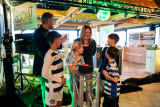
The pioneering innovations were presented of the Scale Up Future-proof artificial turf pitches project, a collaboration between Amsterdam and Haarlem focused on sustainable artificial turf pitches. Over the next few years, more than 250 sports pitches in both cities will be transformed into circular, energy-generating and climate-adaptive sports venues. These artificial turf pitches can not only generate and store energy, but also involve smart water management. An approach that is globally relevant for urban sports infrastructure.
Three consortia collaborate on the sport pitch of the future
The three selected consortia Antea Sport, EnergieVeld and GOO4iT together comprise more than 15 market players. They join forces within this innovation partnership, where there is room for long-term collaboration, co-creation and scalable innovation. The pioneering solutions will make it possible to cool down sport pitches on warm days, help dispose of and collect rainwater, make the pitches more pleasant for the users and possibly even generate energy for the surrounding area. Find out how these innovations are shaping the sport pitch of the future here.
Two municipalities: joint procurement
The Scale Up Future-proof artificial turf pitches project is a unique collaboration between two municipalities and market players. The municipalities jointly procure pooling their purchasing power and use an innovation partnership to challenge the market to test and scale up innovative and sustainable solutions. In doing so, the solutions are also scalable and transferable to other cities in the Netherlands and Europe.
From prototype to pilot fields
The first prototype fields will be constructed in Amsterdam and Haarlem in 2026, in different capacities and combining multiple innovations, where they will be extensively tested and monitored for a year. Successful concepts are then scaled up to full-scale pilot pitches and tested and monitored for another year. This will form the basis for the new standard of sustainable sports pitches, with potential for adoption in other cities around the world. At the same time, existing pitches are already being improved with the most sustainable solutions available, making an immediate impact from the start. The project thus shows how cooperation between municipalities and market players can lead to innovative, climate-proof sports infrastructure with international relevance.
Join us
This project provides cities worldwide a blueprint for sustainable, smart, and future-proof artificial turf pitches. Interested municipalities and industry partners can get in touch and subscribe to our news updates by sending an e-mail to: sportveldvandetoekomst@amsterdam.nl.
Eindconferentie: LIFE Arenapoort project (netcongestie)
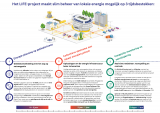
Met het LIFE project in Amsterdam Zuidoost zijn we bezig met een eindconferentie te organiseren op 4 maart middag (13u-17.30) bij de Johan Cruijff Arena en je bent uiteraard van harte welkom (net als je collega's)!
Hieronder de aanmeld pagina met de programma:
[https://www.eventbrite.nl/e/tickets-eindconferentie-life-project-1206732572609](https://www.eventbrite.nl/e/tickets-eindconferentie-life-project-1206732572609 "https://www.eventbrite.nl/e/tickets-eindconferentie-life-project-1206732572609")
Het conferentie gaat over de bijdrage van het LIFE project om innovaties te realiseren om netcongestie te beheren op gebiedsniveau, <strong>in samenwerking met Alliander, Johan Cruijff Arena, Gemeente Amsterdam, TU Delft, Spectral, AMS Institute en andere tech en kennis partners</strong>. Er komen ook inspirerende keynote sprekers om de context te laten zien waarin het project opereert:
- Bart van der Laan, Programmamanager Flexibel Energiegebruik, Alliander
- Ellen Nieuwboer, Projectdirectuer gebiedsontwikkeling, Gemeente Amsterdam
- Roland Lazet (ING) & Andro Bottse (Green Business Club Zuidoost), EnergyHub Arenapoort Taskforce
Samen kijken we naar hoe de onderzoek en tools van LIFE wordt toegepast in Amsterdam Zuidoost om netcongestie op een inclusief en collectief manier te kunnen beheren.
Tot 4 maart bij de Arena!
Project Team LIFE
Netwerkbijeenkomst Positief Energie District in de Tolhuistuin

5 jaar Amsterdam Innovatie Atelier
In Buiksloterham ontwikkelt ATELIER een wijk die meer energie opwekt dan zij verbruikt en worden slimme energietoepassingen in de praktijk gebracht.
Wat komt er allemaal kijken bij het opzetten van een energiegemeenschap, welke mogelijkheden en structuren er nodig zijn voor het actief delen van energie, hoe kunnen batterijen ingezet kunnen worden om netcongestie tegen te gaan, en hoe kan het concept data commons bijdragen aan een duurzame wijkontwikkeling?
In deze bijeenkomst blikken we terug op onze gezamenlijke resultaten en bespreken we de toekomstplannen in samenwerking met het kennisnetwerk Amsterdam InChange.
De dag wordt geopend door de Amsterdamse wethouder Dirk de Jager en georganiseerd door TNO in samenwerking met de Hogeschool van Amsterdam, AMS Institute, Waag Futurelab en gemeente Amsterdam.
Ben jij actief in het veld? Dan ben je van harte welkom en horen we graag jouw reflectie tijdens de kennissessies die zich richten op lokale energiesystemen, energiegemeenschappen, financiering en data delen.
Meld je voor 13 november aan!
Wanneer: 21 november 2024
Waar: Tolhuistuin, IJpromenade 2, Amsterdam
Ga naar de aanmeldpagina voor meer informatie over het programma en de sessies.
Het Amsterdam Innovatie Atelier is onderdeel van het Smart City EU-project ATELIER
Duurzame Bedrijven Dagen
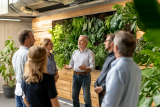
Het verduurzamen van je bedrijfspand levert vaak veel voordelen op, zoals lagere energiekosten, een beter werkklimaat voor werknemers en een verbeterde productkwaliteit. Tijdens de tweede landelijke editie van de Duurzame Bedrijven Dagen van 15 tot en met 28 november delen bedrijven in Nederland hun ervaringen met duurzame maatregelen. Bedrijven die ook hun deuren willen openen voor andere ondernemers, kunnen zich gratis aanmelden via de website van de Nationale Duurzame Bedrijven Route.
Voor ondernemers kan het een uitdaging zijn om aan de slag te gaan met het verduurzamen van hun bedrijfspand. Hoewel er veel informatie beschikbaar is, is het vaak lastig de juiste kennis eruit te filteren. Ook kunnen factoren als tijd en budget als een drempel voelen. De Duurzame Bedrijven Dagen brengen bedrijven met duurzaamheidservaring en andere ondernemers die nog willen beginnen juist samen.
Slim verwarmen bedrijfsruimten
Naast het op weg helpen van andere ondernemers levert deelname voor bedrijven meer landelijke bekendheid op. Daarnaast kunnen ondernemers laten zien dat ze hun pand, terrein of bedrijfsprocessen al (deels) hebben voorbereid op de toekomst. Onderwerpen die tijdens deze dagen bijvoorbeeld aan bod komen, zijn: het slimmer verwarmen van bedrijfsruimten, het opslaan van energie met speciale accu’s of het vergroenen van je bedrijventerrein.
Kop koffie en rondleiding
Met een kop koffie, een goed gesprek of een kleine rondleiding door het gastbedrijf komt op tafel hoe een collega-ondernemer het verduurzamen van zijn pand heeft aangepakt en wat wel of juist niet werkt. Bij een bezoek staan de ervaringen en de handige tips centraal. Ook is het prettig voor bezoekers dat de duurzame maatregelen in de praktijk bekeken kunnen worden.
Bedrijf aanmelden
Wie zijn bedrijf wil openstellen van 15 tot en met 28 november, kan zich aanmelden via: www.duurzamebedrijvenroute.nl/duurzame-bedrijven-dagen/. Een bedrijf geeft zelf aan welke dagen en tijden bezoekers welkom zijn. Bezoekers schrijven zich vervolgens in via de website voor een bezoek aan één van de deelnemende bedrijven.
Over de Nationale Duurzame Bedrijven Route
De Nationale Duurzame Bedrijven Route is een onafhankelijk platform waar ondernemers hun ervaringen, tips en vragen over het verduurzamen van hun bedrijf delen. Sinds de lancering is het platform sterk gegroeid en telt inmiddels bijna 200 deelnemende bedrijven. De Nationale Duurzame Bedrijven Route werkt samen met gemeenten, provincies en de Rijksoverheid. Meer informatie is te vinden op: www.duurzamebedrijvenroute.nl
Subsidie voor ondernemers om inzicht te krijgen in elektriciteitsverbruik: De SON subsidie van de provincie Noord-Holland
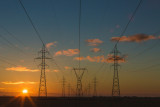
De provincie Noord-Holland heeft opnieuw de subsidieregeling Slimme Oplossingen bij Netcongestie (UVR SON) geopend. Van 1 juli tot 1 oktober 2024 kunnen bedrijven en organisaties subsidie aanvragen om inzicht te krijgen in hun elektriciteitsverbruik. Dit helpt hen om energie te besparen en hun verbruik slimmer te spreiden. De subsidie varieert van € 10.000 tot € 15.000 per aanvraag, met een totaalbudget van € 500.000.
Met deze subsidie kunnen bedrijven en organisaties slimme meet- en sturingssoftware aanschaffen waarmee je inzicht krijgt in je eigen elektriciteitsprofiel. Die meetgegevens kunnen gebruikt worden om elektriciteitsgebruik te verminderen of beter te spreiden over de dag. Lees verder op de websitelink!
Waag Open: energy of the future
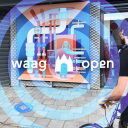
Get up at your feet and join for a summer excursion in Amsterdam-Noord! Although we see more and more solar panels in our streets, as a resident you see very little of the energy transition in the neighbourhood. in Amsterdam, there is already a neighbourhood where the future has started: Buiksloterham in Amsterdam North. Buildings in this area are natural gas-free and almost all of them obtain their energy in a different way.
Be aware that the main language is Dutch!
To make this visible, little glimpses have been placed in the public space. The art objects give virtual glimpses into the devices and installations behind walls and in basements. On the pavement, a 3D painting shows where the district heating network runs, and a viewing tube shows you how full the neighbourhood battery is underground. If you walk past it often enough, you will start to see connections: the weather was really nice today, so the battery is completely full!
During this Waag Open, we'll take a walk alongside different glimpses. All facets of the energy tranisty are covered: we show how deep the boreholes of the thermal storage are and where exactly the heat from the heat network comes from. There is also a focus on solar panels, batteries and heat pumps - of all shapes and sizes! Take a walk with us on Thursday 1 August and you're bound to learn something new about the energy transition!
Programme
| 19:15 - 19:30 | Meetup at Schoonschip (Johan van Hasseltkade 225B, Amsterdam) |
|---|---|
| 19:30 - 19:45 | Welcome & introduction by Waag |
| 19:45 - 21:14 | Walk along the objects |
| 21:15 - 21:30 | Drinks at De Ceuvel |
Circular Cities Summit 2.0
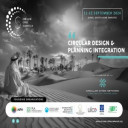
Building upon the resounding success of its inaugural edition in Singapore, the Circular Cities Summit 2.0 is poised to emerge as a beacon of innovation and collaboration in the pursuit of sustainable urban futures. Conceived by eminent vanguards of international professional organizations, including the International Federation of Landscape Architects (IFLA), the International Society of City and Regional Planners (ISOCARP), the International Union of Architects (UIA) and the World Federation of Engineering Organizations (WFEO), alongside other distinguished entities, this summit stands as a resolute clarion call.
This year, we emphasise the integration of circular design principles into urban planning to tackle urgent environmental challenges, including extreme weather, severe traffic congestion, critical air pollution, and issues with thermal comfort. Taking place in Dubai, the summit will explore how concepts from the circular economy can be utilised to boost urban sustainability and resilience.
The summit will serve as a platform for thought leaders, practitioners, and policymakers from around the world to exchange ideas, case studies, and technologies. It aims to inspire the implementation of innovative, sustainable urban planning strategies that adhere to circular economy principles, leading to more resilient, efficient, and clean cities. Participants will depart with actionable insights and strategies, equipped to implement these ideas in their own urban settings to drive significant environmental and infrastructural change.
Follow our detailed roadmap for circular city innovation, outlining the steps to transform urban areas into sustainable, zero-waste environments.
We aim to inspire change, one city at a time.
URLs:
Tickets: https://go.evvnt.com/2461455-0?pid=5603
Website: https://go.evvnt.com/2461455-2?pid=5603
LinkedIn: https://go.evvnt.com/2461455-3?pid=5603
Facebook: https://go.evvnt.com/2461455-4?pid=5603
Prices:
CCN Member: USD 400.00,
Non-member: USD 600.00,
Developing Countries: USD 500.00,
UAE Resident: AED 400.00,
Student: AED 100.00
Date and Time: 11th September 2024 at 9:00 am to 12th September 2024 at 6:00 pm
Ondernemers met duurzame oplossingen gezocht voor aanbesteding
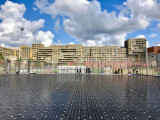
De aanbesteding Scale Up Toekomstbestendige kunstgrasvelden is gepubliceerd. Met het project dagen de gemeenten Amsterdam en Haarlem ondernemers uit om duurzame oplossingen op kunstgras sportvelden toe te passen. De inschrijving hiervoor sluit op 17 juni 2024 om 14.00 uur.
De genoemde gemeenten zijn op zoek naar partijen met innovaties op het gebied van: duurzame energie, klimaatadaptie, circulariteit of slim en schoon bouwen. De duurzame oplossingen willen ze vervolgens toepassen bij de vervanging en nieuwe aanleg van kunstgras sportvelden. Naar verwachting staan er de komende tien jaar meer dan 200 velden op het programma. Hiermee wordt verwacht een grote bijdrage te leveren aan de doelstelling van de gemeenten Amsterdam en Haarlem om in 2050 een klimaatneutrale stad te zijn.
Doe mee!
Doe mee met dit project en schrijf je in voor de aanbesteding op Mercell.
Kijk voor meer informatie op de website van het project of stel je vraag door een e-mail te sturen naar sportveldvandetoekomst@amsterdam.nl.
Disclaimer: Het project wordt medegefinancierd door het LIFE Programme van de Europese Unie. Noch de Europese Unie, noch de subsidieverlenende autoriteit kan voor de inhoud van het project verantwoordelijk worden gehouden. Aan dit artikel kunnen geen rechten worden ontleend, de aanbestedingsdocumenten zijn leidend.
Ondanks congestie toch bedrijvigheid op Schiphol Trade Park

Wat in oktober 2020 begon als een urgent probleem – in het gebied waar Schiphol Trade Park in ontwikkeling was was geen extra transportcapaciteit meer mogelijk en de geplande bouw en uitbreiding moest noodgedwongen stoppen – is inmiddels opgelost. Onze baanbrekende virtuele netoplossing is daar nu namelijk ruim twee jaar in werking, en met succes: de bedrijven op Schiphol Trade Park zijn operationeel, breiden uit, en elektrificeren ondanks de netcongestie in het gebied.
Congestie op Schiphol Trade Park
Een blik op de congestiekaart maakt duidelijk dat Schiphol Trade Park in een door congestie grotendeels op slot gezet gebied ligt. Op het middenspanningsnet is geen extra capaciteit beschikbaar voor het transporteren van elektriciteit. Dat betekent dat er niet meer ontwikkeld wordt: een bedrijf krijgt namelijk wel een aansluiting, maar geen transportcapaciteit. Dit is niet alleen een probleem voor de bedrijven die zich hier willen vestigen, maar ook voor gebiedsontwikkelaar SADC (Schiphol Area Development Company), dat in 2020 nog de ambitie had om het meest duurzame business park van Europa te worden (en in 2023 door de BREEAM-NL Outstanding certificering zelfs het meest duurzame logistieke business park van de wereld is!). De ontwikkelaar wilde voorkomen dat bedrijven afzonderlijk een eigen oplossing zochten en er een wildgroei aan gasgeneratoren met de daarbij behorende uitstoot zou ontstaan. SADC zag dat dit slimmer, goedkoper en duurzamer kon, door op een innovatieve manier partijen te verbinden en te laten samenwerken. Bedrijven kunnen daardoor bouwen, uitbreiden en elektrificeren. Over de aanloop naar het project lees je meer op onze projectpagina.
Een doorbraak: de virtuele netoplossing
Alle bij de coöperatie aangesloten bedrijven delen hun eigen transportcapaciteit met elkaar. Zo maken ze slim gebruik van de gereserveerde ruimte. STELLAR Grid Management leest continu de slimme meters uit en stuurt de energiesystemen (zoals zonnepanelen, energie-opslag, en generatoren) achter de meter aan. Bovendien zorgen we voor de financiële afhandeling van deze aansturing, zodat de deelnemende bedrijven elkaar compenseren voor gebruikte elektriciteit en voor het beschikbaar stellen van hun stuurbare energiesystemen.
De resultaten van een jaar virtueel net
Het virtuele net is twee jaar actief. In het eerste jaar sloten zich nog gefaseerd bedrijven aan bij het collectief. De resultaten van dat jaar zijn voorspoedig, maar niet helemaal volledig.
Nu we een tijdje bezig zijn, delen we met vertrouwen onze resultaten. Voor deze resultaten keken we naar 2023. Zo nemen we dus alle seizoenen en bijbehorende energievraag mee in deze analyse.
Het collectief wordt goed benut: in 2023 is 2.104 MWh aan elektriciteitslevering extra mogelijk gemaakt door het delen van de capaciteit binnen het virtuele net. Zonder deze slimme oplossing hadden heel veel stuurbare energiesystemen, zoals batterijen en generatoren, deze elektriciteit moeten leveren. In het collectief nemen in totaal zeven bedrijven deel die weinig of geen netcapaciteit hebben. Dankzij deze slimme oplossing kunnen de bedrijven gebruikmaken van de beschikbare ruimte en opwek van de buren.
Om zeker te zijn van voldoende elektriciteit binnen de gestelde limieten hebben meerdere bedrijven geïnvesteerd in batterijen en gas- en dieselgeneratoren. Het collectief gebruikt die middelen als er een tekort aan capaciteit is. De generatoren dienen vooral als achtervang. Voordat STELLAR deze aanstuurt, bepaalt het systeem of de aangesloten batterijen kunnen voorzien in het verwachte moment van schaarste. Als de batterij niet voldoende is, schakelt STELLAR automatisch een generator in. In heel 2023 is ertwee keer een generator ingezet om binnen de netlimiet te blijven, voor in totaal 2 uur. Toen de generatoren aangingen waren de batterijen nog niet operationeel, anders waren die generatoren waarschijnlijk niet nodig geweest.
Zonder virtueel net hadden deze partijen moeten investeren in elk een eigen generator (en eventuele back-up generator). Die generatoren hadden gezamenlijk tot 31.000 draaiuren gemaakt. Dat is gelukkig voorkomen. Er is hiermee voor 468.000 m3 minder gas verbruikt, en daardoor is er lokaal 842 ton CO2 minder uitgestoten door generatoren.
Het virtuele net is dus een solide oplossing voor congestiegebieden. Dankzij de slimme aansturing zijn zeven bedrijven operationeel die zonder de virtuele netoplossing hadden moeten uitwijken naar een andere locatie in Nederland of daarbuiten,terwijl een aantal van hen al aan het bouwen was. En er is een enorme hoeveel CO2-uitstoot voorkomen.
De toekomst van Grid Management
We zijn trots op ons virtuele net bij Schiphol Trade Park. We horen ook een enorme urgentie in de markt: veel partijen worstelen met netcongestie en zoeken naar een vergelijkbare oplossing. Maar de toekomst van Grid Management is niet hapklaar. Het project bij Schiphol Trade Park is een pilot, en de voorwaarden van een standaard contractvorm voor een dergelijke collectieve oplossing (groeps-transportovereenkomst) zijn nog niet definitief vastgesteld.
Niet alleen bij Schiphol
Schiphol Trade Park is zeker niet de enige plek in Nederland waar sprake is van congestie. Eerder dit jaar lanceerden we onze oplossing bijvoorbeeld ook in het Zwolse Hessenpoort. Heb jij ook last van congestie? We denken graag met je mee. Neem contact met ons op.
Financing- and investment options for the Clean Energy transition.
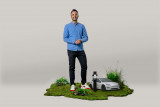
Recognizing the significance of clean tech is pivotal in accelerating the energy transition and shaping a more sustainable future for our planet. However, these solutions are hindered by limited funding options for sustainable companies.
DuurzaamInvesteren.nl is committed to speeding up the sustainability transition by facilitating the right financial solutions for clean energy companies and democratizing investment opportunities. As an alternative investment solution, we connect entrepreneurs with investors and vice versa through our platform.
Founded in 2013, we now are the largest Dutch sustainable investment platform offering alternative finance solutions. We offer guidance, quick turnaround times and flexible terms & conditions and developed a renowned sector expertise in the clean energy transition.
Over the past 10 years we've financed over 335 million euros and we are proud to be a network of more than 17.000 investors. We have helped over 278+ green projects and companies to grow.
Join our webinar to hear more about speeding up the transitions and the opportunities as a sustainable entpreneur or investor.
Details
Date: Tuesday March 26
Time: 7:30-8:30 PM
Duration: 1 hour
Program
- Welcome and opening by CEO Dennis Kromhout van der Meer.
- How DuurzaamInvesteren.nl accelerates the energy transition
- Cases
Marty Smits, founder Refurb battery and Sosimple:
Refurb battery won the Brabant Circular Innovation Award in 2023 and raised 1.15 million euros within 24 hours through DuurzaamInvesteren.nl. Refurb battery supports the energy transition by developing circular battery storage systems and eliminating the increasing amount of li-ion waste.
Marty Smits is also the founder of Sosimple, whose mission is to make clean energy accessible and affordable for everyone and every company in South Africa. SoSimple does this via company roofs throughout South Africa. There are 50 installations live and 15 in development. DuurzaamInvesteren.nl raised more than 5 million for Sosimple.
- How to invest in clean tech energy solutions
- How to raise finance as an entrepreneur via DuurzaamInvesteren.nl
- Q&A Session
Moderation
Ilse Kwaaitaal, director Impact Hub Amsterdam. Impact Hub Amsterdam is part of a worldwide entrepreneurial network that focuses on scaling innovative sustainable solutions through connecting them to finance, knowledge and a valuable growth network.
Note: this event will be in Dutch.
Join our event here: https://lu.ma/kx7gj504
Demoday #22: How can we continue to facilitate homeowners in driving the energy transition?
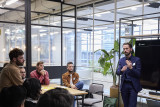
Grid congestion is becoming increasingly significant and will start to pose a problem in the low-voltage network in the coming years. This will prevent homeowners from transitioning away from gas, result in low efficiency for their solar panels, and could make it impossible to have a charging station at their doorstep. Alliander does not want to hinder the energy transition. Therefore, they are looking for a way to involve homeowners in the issue of grid congestion and provide solutions that are still feasible with a crowded grid.
In the energy work session on the 14th of December, Wouter van Rooijen (Alliander) discussed the challenges related to grid congestion. From 2030 onwards, it is expected that a significant portion of the low-voltage network will experience both over- and under-voltage. While the network will be reinforced as quickly as possible, the lack of labour capacity is also prompting the consideration of alternative solutions.
The solution that emerged from Wouter's co-creation process was WijkWise. In this work session, Wouter aimed to validate the WijkWise concept and find parties that could contribute to its development and market implementation. Dave van Loon from Kennisland moderated the session.
WijkWise – Understanding the neighbourhood's grid situation
The WijkWise concept focuses on three problems:
- The growth of grid congestion at low-voltage
- Homeowners' uncertainty about making sustainable investments. For instance, because they may not know if their solar panels will yield a good return.
- Homeowners' lack of awareness regarding the impact their choices have on the stability of the grid.
The proposed solution:
"With WijkWise, Alliander continues to facilitate homeowners in making their homes more sustainable. Alliander does this by providing insight into the neighbourhood's grid situation and recommending the best investment. Residents can make informed choices that contribute to payback time, comfort, and certainty. A good choice benefits both the homeowner and the grid operator."
The idea is to provide more insight into the neighbourhood's grid situation and offer tailored advice for home sustainability. This way, homeowners can determine whether they should invest in insulation, a heat pump, or solar panels.
Alliander does not want to develop this concept alone, but is seeking partners to bring this concept to market.
Discussion
After the concept presentation, a brief discussion followed. The main questions raised were:
- Can providing insight into the neighbourhood's grid situation have (negative) effects on the housing market?
→ They don't know yet; further investigation is needed. - Can this data be shared freely?
→ The data shared will be at the neighbourhood level (transformer level) and not in real-time (monthly). If there is user data involved, consent must be obtained. - What behaviour change do you expect?
→ That, during the investment moment, consideration will be given to the grid situation for the most advantageous investment.
After the discussion, we worked in groups with the Empathy Canvas from Kennisland to view the WijkWise concept from the perspective of the homeowners. This tool helped us really view the problems from the perspective of a homeowner.
Empathy Mapping
In three groups, we delved into the homeowner's situation. The recurring themes in the empathy maps were:
- A sense of unfairness for the homeowner. They invest in sustainability and are rewarded with grid congestion problems.
- A feeling of uncertainty for the homeowner. They want assurance that their investment will yield results.
- Little trust in the grid operator and the government. First, everyone had to get solar panels, and now suddenly it doesn't fit, and net metering is being discontinued (or not?)
- Limited understanding by homeowners because they find it very complicated and don't want to delve into it. It's not an urgent problem for them.
- Collaboratively seeking solutions can be very positive, but can also lead to friction.
Alliander plans to take the next steps with this concept in 2024. In 2024, they are planning to do the follow-up research, make the minimal viable product, and launch the first version of the product at the end of the year.
Do you know of any stakeholders that absolutely need to be involved, or would you like to be involved in the implementation of the WijkWise concept? Please contact Noor at noor@amsterdamsmartcity.com. Special thanks to Wouter and Dave for this interesting session.
De energietransitie vraagt om eerlijkheid en duidelijke randvoorwaarden
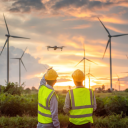
De energietransitie is een van de grootste uitdagingen van deze tijd. Nederland heeft tot nu toe goede stappen gezet, maar om de klimaatdoelen te behalen, moet er nog een flinke inhaalslag worden gemaakt. Wat is er nodig en wat is de rol van de overheid in deze transitie? Sander Oudmaijer en Ariën de Klerk, beiden werkzaam bij Monitor Deloitte, doen aanbevelingen gebaseerd op onze onlangs gepubliceerde Energie Transitie Monitor.
We hebben in Nederland de afgelopen decennia goede vooruitgang geboekt, máár om de klimaatdoelen van 2030 en daarna te halen, is er nog een flinke versnelling nodig, constateren Sander Oudmaijer, Director bij Monitor Deloitte, en Ariën de Klerk, Manager bij Monitor Deloitte. Ze baseren zich op de Energie Transitie Monitor (ETM) die Deloitte begin september gepubliceerde. Om de juiste keuzes te kunnen maken, hadden professionals uit de industrie, academici en beleidsmakers al langer behoefte aan een helder beeld en een gemeenschappelijke feitenbasis over de status van de energietransitie. De ETM biedt die huidige stand van zaken over de energietransitie in Nederland en laat zien wat ons te wachten staat.
Omvang van de Nederlandse emissies
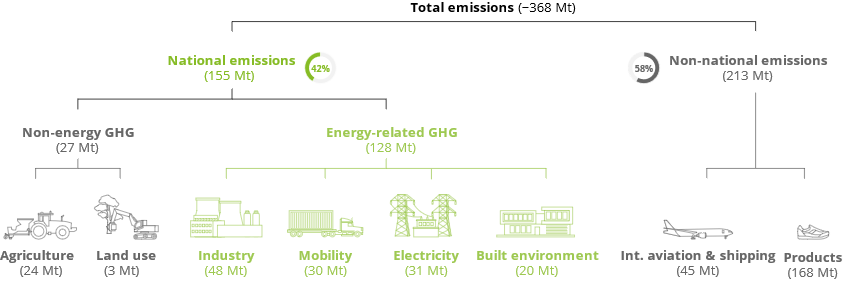
De Klerk: “Tot nu toe hebben we keuzes gemaakt die relatief weinig pijn deden. Het grootste deel van de vooruitgang boekten we door laaghangend fruit te plukken, en mee te liften op ontwikkelingen die zich sowieso al voordeden. Denk aan het terugdringen van de industriële productie, efficiëntiemaatregelen en het feit dat we meer gebruik maken van bestaande technologieën zoals zonne- en windenergie. Om de klimaatdoelen te halen, ontkomen we er niet aan om nu ook keuzes te gaan maken die pijn doen.”
Oudmaijer: “Om de doelstellingen uit het klimaatakkoord in 2030 te halen, moeten er 570 laadpalen per dag worden geïnstalleerd en moeten er tien emissievrije bussen per week bij komen. Daarbij zouden we de verwarming van 600 huizen per dag moeten elektrificeren en moeten we tot 2050 om de dag één windmolen bouwen. Om dat voor elkaar te krijgen zullen er fundamentele keuzes gemaakt moeten worden.”De Klerk: “De pleisters om kleine tekortkomingen te repareren raken op.”
Vertel het eerlijke verhaal
De rol van de overheid in de energietransitie is dan ook van groot belang, stellen Oudmaijer en De Klerk. De overheid schept de voorwaarden die nodig zijn om de doelen te kunnen behalen, en ze draagt tegelijk bij aan het vertellen van 'het eerlijke verhaal'. Oudmaijer: “Het is belangrijk dat er nu subsidies zijn voor elektrische auto's en allerlei duurzame maatregelen, maar dat houdt een keer op. De energietransitie gaat zowel burgers als bedrijven geld kosten. Dat eerlijke verhaal moet verteld worden.”
"De vraag is niet of we nog een windmolenpark gaan bouwen op zee óf op land, het moet allebei."
De Klerk: “Bovendien is het nog vaak een of/of-discussie, maar de vraag is niet of we nog een windmolenpark gaan bouwen op zee óf op land, het moet allebei. Daarbovenop zijn investeringen in andere vormen van energievoorziening, zoals bijvoorbeeld kernenergie, noodzakelijk. Ook dat is het eerlijke verhaal: het is en/en.”
Oudmaijer: “De ETM laat duidelijk zien wat er moet gebeuren. Een belangrijke vraag is vervolgens hoe je gemeenschappen meekrijgt met al deze ontwikkelingen. Eigenlijk wil niemand een windmolenpark in zijn achtertuin. Als overheid moet je daarom nadenken hoe je dit zo goed mogelijk kan faciliteren. Wellicht moeten de voordelen van wind- en zonne-energie op een directere manier terugvloeien naar bepaalde gemeenschappen, zodat zij enthousiaster worden en meer betrokken raken. Zoals bij het windpark Veur de Wind, waar omwonenden meeprofiteren van het park, in plaats van dat het ze met dwang werd opgelegd.”
De Klerk: “Al dit soort zaken vragen om een heldere visie vanuit de overheid. Het moet voor investeerders en bedrijven duidelijk zijn wat ze van de overheid kunnen en mogen verwachten en hoe die hen kan helpen. De overheid schept duidelijke randvoorwaarden voor de langere termijn. Als we om de dag een windmolen willen bouwen, dan moet onder meer de termijn om een vergunning te krijgen voor de bouw van een windmolenpark vele malen sneller dan nu het geval is.”
Win-winsituaties
We hebben in korte tijd veel werk te doen. Niettemin zijn volgens Oudmaijer en De Klerk de juiste bouwstenen aanwezig om dit succesvol aan te pakken. Denk bijvoorbeeld aan een innovatiecultuur, een al lang bestaande industriële sector en een toonaangevend onderwijssysteem. De uitdaging die voor ons ligt, is om al onze capaciteiten op vernieuwende wijze te orkestreren en de transitie te versnellen op een manier die samenleving, klimaat en economie ten goede komt.
De Klerk: “Wat je niet wilt is dat bedrijven hun deuren in Nederland sluiten en in een ander land met dezelfde uitstoot verdergaan. De vraag is dus hoe we ervoor zorgen dat we economische daad- en draagkracht houden zonder daarbij onze verantwoordelijkheid ten aanzien van het klimaat te verzaken. Oftewel, we moeten opnieuw kijken wat onze rol is in de energietransitie en waarin we willen investeren als B.V. Nederland. Belangrijk is dat die keuzes passen bij de capaciteit van ons land en hetgeen waar we goed in (willen) zijn.”
Oudmaijer: “We zijn in Nederland al een tijd bezig met waterstof, mede om de grote industrie te faciliteren. Als we ervoor kiezen om daar vol op in te zetten, dan zou de overheid met een duidelijke visie moeten komen. Stil staan bij vragen als: Op welke type waterstofdragers zetten we in? Waar willen we waterstof wel en niet voor gebruiken, en hoe gaan we dat als overheid faciliteren? De overheid zal een faciliterende rol moeten pakken, zodat bedrijven een afgewogen investeringsbeslissing kunnen maken. Bijvoorbeeld door te zorgen dat er sneller vergunningen worden afgegeven, het duidelijk is waarvoor we het willen gebruiken en door locaties aan te wijzen waar fabrieken gebouwd kunnen worden.”
De Klerk: “Een ander idee is om het North Sea Consortium te versterken door een visie en een uitvoeringsplan te creëren. Dat positioneert de Noordzee als een krachtcentrale van de Noordwest-Europese offshore op het gebied van windenergie- en waterstofproductie. Op die manier zet je Nederland neer als krachtpatser en dient het als een mondiale blauwdruk voor een succesvolle energietransitie.”
Oudmaijer: “Begin hiermee door als overheid een duidelijke visie neer te leggen en samen met het bedrijfsleven pilotprojecten te starten om uit te vinden wat wel en niet werkt. Een iteratief proces waarbij overheid en bedrijfsleven hand in hand de meest succesvolle initiatieven verder brengen, waardoor duidelijk wordt wat daadwerkelijk impact oplevert. De tijd om het laaghangend fruit te plukken is voorbij, het gaat nu om heldere keuzes en concrete acties!”
ATELIER - Positive Energy Districts

ATELIER is an EU funded project about AmsTErdam and BiLbao cItizen drivEn smaRt cities, aiming to create and replicate Positive Energy Districts (PEDs) within eight European cities. ATELIER showcases innovative solutions that integrate buildings with smart mobility and technologies to create rather than consume energy in its two Lighthouse Cities Amsterdam (Netherlands) and Bilbao (Spain). The Fellow Cities of ATELIER, Bratislava (Slovak Republic), Budapest (Hungary), Copenhagen (Denmark), Krakow (Poland), Matosinhos (Portugal), and Riga (Latvia), will replicate and adapt the successfully implemented solutions and thus serve as testbeds for future smart cities. Overall, ATELIER will thus generate an energy surplus of 1340 MWh of primary energy and save 1,7 kt of CO2 and 23 t of NOx-emissions.
To achieve successful implementations of energy saving measures, ATELIER puts citizens at the centre of all its activities: residents (<9000), local initiatives and energy communities will be included in decision-making processes and activities and will be strongly engaged in the development of the technical solutions throughout the project. Citizens will be involved in the Innovation Ateliers to create a maximum impact for the PEDs.
30 partners from 11 countries are working in 10 work packages.
Learn more about ATELIER at its public website (http://www.smartcity-atelier.eu/) or via the ATELIER Twitter and LinkedIn channels. Sign up here (link follows) for the ATELIER newsletter. Follow the project virtually and don’t miss an opportunity to come talk to its partners at events to learn more about how ATELIER will improve the life of its citizens and the liveability in its cities!
The next step for Local Energy Systems
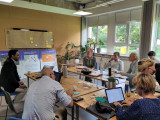
Thursday, the 30th of August, we had the first follow-up session about Local Energy Systems (LES) since the Transition day session in June. Over the summer Omar Shafqat (HvA, ATELIER), dr. Renée Heller (HvA), and Lennart Zwols (municipality of Amsterdam), have worked on finding a solution to the barriers to scaling up LES. They focused on the barrier of sharing information and learnings of LES projects. In this session, Omar presented a framework that could help overcome this barrier.
A barrier to scaling up LES: Lack of knowledge
In the previous session, we discussed how the difficulty with starting a new LES project is often that the information on how to do this is not readily available. Many pilots have been done, or are still ongoing, and there are definitely reports on the learnings of these pilots. Unfortunately, these learnings are not always available to everyone, and if they are, quite difficult to find and aggregate.
Lennart therefore proposed to make a framework in which we can gather all the information on LES pilots and projects, so we have a central place for the collecting and sharing of information. Omar and Renée have created this framework, which Omar presented in this session. The framework has three objectives:
1. Collecting the learnings of the pilots in one place.
2. Defining the gaps in our knowledge.
3. Creating a starting point for people who want to create their own LES.
Definition of a Local Energy System
To properly create a framework in which various information of relevant LES projects can be collected, it was necessary to have a good definition of a LES. Omar presented the definition as follows:
A local energy system is an interactive, non-linear system that must contain:
- Local generation
- Controllable demand
- Storage
- Energy Management Systems
- Energy communities
Hans Roeland Polman (AMS) commented that he was missing the infrastructure in this definition. Omar clarified that the lines between these five entities symbolize the infrastructure and that it is indeed an important component of LESs.
When we speak of LES it is always a balancing act. Different stakeholders have different objectives for implementing a LES, maximizing renewables, minimizing costs, flexibility/congestion, grid dependence, etc. This implies that the aspects of a LES are of differing importance to stakeholders, which is important to take into account with information gathering and sharing.
The first version of the framework for collecting information
After discussing the definition of LES, we dived into the framework. The goal of this framework is to have one format in which we collect information and learnings from all the LES pilots and projects (starting with the ones in our own network). This will allow us to speak a common language, easily compare projects, identify stakeholders and their interests, see where the knowledge gaps are, and more easily find specific information about LES.
Note: This framework is not the interface for the end-user. The framework should be used to catalogue information and learnings so that we have the information on all the different projects in the same format. We can then use this to build a user interface that end-users can interact with. How to best do this is still a topic of discussion.
The framework is presented below. On the x-axis, you can see the time scale. On the left you have the long-term (planning) phase, and on the right the short-term (management) phase.
On the left side, you can see the four areas in which the framework is divided:
- Policy
- Energy markets
- Energy systems
- Community/user aspects
The colour-coded third dimensions show which blocks relate to certain topics of interest, and should have information added on this topic. The topics of interest that have been added now are:
- Congestion
- Energy balance
It might be interesting to add others as well.
It was suggested by the group that electricity/heating might also be an interesting topic to add. Hans (AMS) also suggested that it would be interesting to add information about local infrastructure, such as a local heat network.
Discussion and questions
After the presentation of the framework a discussion followed. Many questions were raised which require further examination. A few of the key questions were:
- What should the scope be of this framework? Are we just looking at our own region, or do we want it to be used on a much larger scale?
- How do we connect to the other organizations and projects to this framework, and refrain from doing double work?
- Who is the owner of this framework and will keep it up to date?
- To make this framework usable for project managers, it should have a clear template that can be filled in. Who is going to make this, and how do we ensure that project managers of LES projects fill this in?
Next steps and call to action:
There are still many questions that need to be answered, and we will continue the research and learn by doing. We will start with the ATELIER and the LIFE project, to see if we can put them into this framework. This will be done by Omar (HvA, ATELIER), and Hans (AMS, LIFE). They will also create the first version of a template in which the information can be collected so that project managers can fill out this information. This will then be tested with the project managers of the LIFE project to see if the template and framework are indeed workable.
This will give a good starting point to see if the framework is suitable for the collection of information and learnings of LES projects. However, it will be far from complete. The ATELIER and LIFE projects don’t contain all the topics to properly test the framework and create templates for everything. We therefore need more partners with LES projects that can help test and develop this framework.
So if you are working on a Local Energy System project, and you would like to help further develop the framework, by giving feedback on the framework itself or using your project to validate the effectiveness of the framework, please let us know.
SESA project – Smart Energy Solutions for Africa to accelerate the green transition and energy access

Context
Africa is the fasted growing continent on the planet, measured both in GDP as in population, which historically is accompanied with a growth in energy consumption. With an eye on the Paris Agreement and COP26 it is clear the energy should be Low or even Zero Emission. However, it is important this does not stifle the economic growth allowing millions to climb out of poverty. With this in mind the EU funded the SESA project that aims at mitigating climate change while improving access to sustainable energy under affordable, reliable conditions.
Project brief
SESA is a four-year (2021-2025) EU H2020 funded R&D project designed to combine innovative energy access solutions for a range of applications in both urbanised and rural contexts in Africa. These solutions will include decentralised renewables (solar photovoltaics), innovative energy storage systems (including second life batteries), waste-to-energy systems (biomass to biogas), smart microgrids, (micro) mobility solutions, climate-proofing, resilience and adaptation, and rural internet access.
SESA focusses on testing, validating and replicating those energy innovations through co-developed demonstration actions in 9 sites across the continent (1 Living Lab for testing, 4 for validation and 4 for replication).
The collaborative project is the result of a strong partnership between leading European and African universities, research centres, industry actors, local governments, knowledge and implementation organizations and networks.
Objectives
The main goal of SESA is to support a diversity of affordable solutions that help provide access to reliable, affordable, and sustainable energy services for all, creating new business opportunities and developing concepts that can directly contribute to a low-carbon development. It further provides policy makers with recommendations aiming at creating a favourable regulatory environment to ensure long-term impacts of the solutions developed. In addition, a key deliverable for the project is the SESA Toolbox, which will contain materials relating to the following main building blocks:
- Impact assessment
- Capacity building
- Business plans and models
- Innovations tested in demonstration actions
- Design, operations and management for different solutions
- Financing & funding options
- Policy support
Cenex NL’s key contributions
Cenex NL leads the work package responsible for the development of the key repository of the project, the so called “SESA Toolbox”, and the evaluation of the project results available in the toolbox. Our team will be involved in three tasks:
- Build a scalable and harmonised toolbox for advanced implementation, management and operation strategies of efficient sustainable energy solutions.
- Develop an evaluation framework based on the Life Cycle Assessment (LCA) methodology to quantify and compare the environmental impacts of the proposed solutions.
- Assess the impact of the solutions developed in at least five the demonstration and validation projects using the framework developed in the previous task.
This project has received funding from the European Union’s Horizon 2020 research and innovation progamme under grant agreement No 101037141
Vacature Technisch Projectmanager (Smart Energy Solutions)
De rol
Als onze nieuwe projectmanager:
- Communiceer je met allerlei belanghebbenden over het beloop van projecten. Intern zijn dat bijvoorbeeld: de business developers, finance manager, het product & delivery team, en het managementteam. Je communiceert extern met onze klanten, partners, en leveranciers.
- Je begeleidt projecten van begin tot einde: je stapt in tijdens het tekenen van het contract, begeleidt de ontwikkeling, en viert de succesvolle oplevering.
- Je staat klanten, indien nodig, bij tijdens het gebruik van onze producten.
- Je bepaalt samen met business development de scope van het project en definieert de doelen die we willen behalen.
- Je bereidt samen met business development de budgetten voor, gebaseerd op de scope van het project en de vraag vanuit het team.
- Je houdt de kosten van het project bij, zodat we binnen budget blijven.
- Je ontwikkelt een gedetailleerde planning voor het project, inclusief mijlpalen en updatemomenten, en houdt die bij.
- Je communiceert consistente updates naar interne en externe belanghebbenden over de strategie, aanpassingen, en de voortgang.
- Je beheert de contracten met leveranciers en communiceert onze verwachtingen met hen.
- Je meet de resultaten van de projecten en identificeert mogelijke verbeterpunten.
- Je reist indien nodig naar onze klanten (binnen Nederland) om met hen te overleggen.
Teamgrootte: 5
Rapporteert aan: Technical Project Manager Team Lead
Over jou
Je bent een ervaren project manager met een hart voor duurzaamheid die op zoek is naar een volgende uitdaging.
MUST-HAVES
- Minstens 2 jaar ervaring in projectmanagement en dergelijke rollen
- Minstens 3 jaar ervaring in ten minste een van deze branches:
○ Smart grids
○ (Hernieuwbare) energie(opslag)
○ Control & automation
○ Software engineering
○ ICT-systemen - Bewezen vermogen om problemen creatief op te lossen
- Je bent bekend met projectmanagementsoftware (zoals ASANA) en -methodes
- Ervaring met het managen van projecten van begin tot einde
- Uitstekende analytische vaardigheden - je ziet het verschil tussen de hoofdboodschap en de ruis eromheen
- Sterke socialevaardigheden, of je gesprekspartner nou je collega, een klant, of een partnerbedrijf is
- Bewezen vermogen om projecten af te maken volgens de geplande scope, budget, en tijdslijn
- Je spreekt en schrijft vloeiend Engels (de voertaal op kantoor is Engels)
- Je spreekt en schrijft vloeiend Nederlands (onze klanten bevinden zich voornamelijk in Nederland)
NICE-TO-HAVES
- Ervaring met ontwikkelgereedschap zoals GITlab
- Ervaring met electrische/duurzaam energie systemen
- Ervaring met power systems en SCADA systemen
Ons aanbod
- Marktconform salaris met bonus bij goed functioneren van het bedrijf en het team
- Twee keer per week biologische, vegetarische lunch op kantoor, vrijdagmiddagborrel, vers fruit
- Uitdagende rol in ambitieuze, internationale werkomgeving, met veel ruimte voor eigen inbreng en persoonlijke ontwikkeling
- Hecht en gezellig team
- De kans om écht het verschil te maken in de mondiale energietransitie
- Bijzondere, innovatieve projecten met impactvolle, toonaangevende klanten en partners
De startdatum is flexibel, maar je zou direct kunnen beginnen.
Lees hier meer over ons en over onze projecten hier.
Klinkt goed? Klik op onderstaande knop om te solliciteren. We kijken ernaar uit van u te horen!
Vacature Technisch Consultant/ Energy Consultant at Spectral
De rol
Je wordt onderdeel van het Spectral Consultancy Team, een klein team van consultants en engineers met een grote drive om innovatieve en impactvolle projecten te kick-starten.
Als technisch consultant ga je een belangrijke bijdrage leveren aan het begeleiden en adviseren van onze opdrachtgevers op het snijvlak van duurzame gebiedsontwikkeling en intelligente energienetwerken.
De projecten die wij uitvoeren zijn bij voorkeur gericht op de mogelijke implementatie van één van onze (toekomstige) smart grid platformen om daarmee duurzame impact te realiseren. Ons werk bestaat uit technisch-financiële haalbaarheidsstudies, potentie-analyses voor het ontsluiten en vermarkten van flexibiliteit, het ontwerpen van integrale, duurzame energieoplossingen en het begeleiden van tendertrajecten voor bijvoorbeeld batterijsystemen.
Jouw technisch (voor)ontwerp en overzicht van technische en functionele eisen vormt de start voor het werk van de development teams binnen Spectral.
Je werkt hierbij dagelijks samen met je collega's van het Consultancy Team en met de andere specialisten en developers die binnen Spectral rondlopen.
Binnen een project worden er verschillende vaardigheden van je gevraagd: de begeleiding van het gehele proces, maar ook subtaken als het eerste kennismakingsgesprek, het formuleren en formaliseren van de opdracht, het (mede) uitvoeren van de adviesopdracht of het technisch ontwerp en het geven van en een wervende eindpresentatie.
Met jouw inhoudelijke expertise en scherpe visie op het gebied van slimme, integrale en duurzame energietechnologieën breng je het Consultancy Team naar een hoger niveau.
Deze functie is gevestigd in Nederland
Over jou
MUST-HAVES
- Je hebt minimaal 2 jaar relevante werkervaring op het gebied van (duurzame) energie, bij voorkeur als technisch consultant of engineer
- Je hebt een afgeronde HBO/WO opleiding in een technische richting met een sterke interesse in (duurzame) energietechnologie
- Je bent communicatief sterk, zowel in woord als geschrift, in Nederlands (moedertaal) en Engels (Engels is de voertaal binnen Spectral)
- Je krijgt er energie van om samen te werken met opdrachtgevers, stakeholders en het interne team
- Je staat ervoor open om te ontdekken waar je, buiten het consultancy team om, binnen Spectral nog meer waarde kan toevoegen en je talenten tot uiting kunt brengen
- Je bent technisch sterk onderlegd en hebt een veelzijdige en analytische blik op de energietransitie.
- Je bent in staat om vanuit een helikopterview problemen te analyseren, oplossingen aan te dragen en dit te vertalen in een technisch (voor)ontwerp.
- Je bent ondernemend, proactief en leergierig en in staat om zowel zelfstandig als in een team te werken
- Je voelt je comfortabel in een relatief jonge en snelgroeiende organisatie met een turbulente en ambitieuze werkomgeving waar we allemaal net even dat stapje extra zetten om de klantverwachting te overtreffen en impact te maken
- Je hebt, net als de rest van het team, een tomeloze drive voor duurzame energie-innovatie en je krijgt al energie bij de gedachte aan het verder (internationaal) opschalen van de onderneming
NICE-TO-HAVES
- Modelleerervaring (bijvoorbeeld Python of MATLAB)
- Ervaring met business case berekeningen
- Je krijgt energie van het scoren van new business
Kom bij het team
CV en motivatiebrief dient in het Nederlands te zijn
Klinkt goed? Solliciteer dan via https://jobs.spectral.energy/technisch-consultant
Transition day 2023: Local Energy systems, scale up, scale up, scale up

Energetic for energy
The technology is here. People and organizations are there. We have a lot of learnings from innovation pilots like Live and Atelier: we're all set. And yet, scaling up local energy systems like Live and Atelier seems to be incredibly difficult. What are the obstacles and barriers to scaling up these initiatives? These questions were the focus of the working session "local energy systems, scale up, scale up, scale up”. The partners unanimously recognized the issue of scaling up as it affected all of them, and enthousiastically engaged in the work session.
Barrieres for upscaling
Together we searched for the actual challenges where local energy systems can be a solution, and the barriers for upscaling. We looked at the first actionable follow-up steps to achieve the required upscaling.
We chose a <em>chair battle</em> as work format and had an open and honest conversation about the challenges we face. It was fascinating to see that sometimes the different stakeholders, despite having the same goal, cannot come to an agreement and this can lead to considerable frustration.
What we learned?
A lot! The picture report says more than a thousand words, but in short:
· We can only solve this challenge together; and that’s difficult
· Citizens and companies often do not know where to go and often do not know the existing possibilities
· We have the same goal, but there are many different interests
· The solutions are already there
And now?
We will continue the topic with great energy in the coming period and try to set up a fixed program structure to keep the development up to speed.
Do you want to know more about this challenge? Please let me know. patricia@amsterdamsmartcity.com
Demo Day #20 : Upscaling ATELIER Buiksloterham

To mitigate climate changes and reduce CO2 emissions, the transition of the current energy system to a more sustainable and decentralized one is needed. In Amsterdam, the Buiksloterham demonstration project from ATELIER is paving the way for this transition. Buiksloterham is a Positive Energy District (PEDs) in practise, in which a local smart energy system and P2P trading governed by a citizen’s energy cooperation is implemented. The ambition of ATELIER/Amsterdam University of Applied Sciences is to research how to upscale and replicate this PED. For the Demo Day on the 16th of May, the Amsterdam University of Applied Sciences asked the Amsterdam Smart City network to discuss how we can learn from the Buiksloterham project to support replication and upscaling. Read through the most valuable outtakes from this session below.
What learnings to focus on?
Starting off, the participants pointed out that it would be most important to learn which choices have been made and why. Therefore, we need to keep track of these decisions and their outcomes. It was suggested to write down all the arguments for the choices made and create a matrix that shows what works or doesn’t work.
It would also be useful to make an impact assessment that shows how much CO2 and electricity is being saved a year. Another great source of information would be around collaboration, specifically with the network operator for example. How did the connection of the PED to the grid go and what learnings are to be gained from that collaboration wise?
Drivers for community involvement
Gathering the insights around community involvement would also be helpful. Danijela and Renée, from the Amsterdam University of Applied Sciences, explained how it has been difficult to get the community involved in the project. Based on the experience of the worksession participants, we concluded this is an issue in other local energy system projects as well. It would be great to investigate why this is the case and what the residents need/desire.
The participants suggest looking at the project from the (possible) resident’s point of view; Why would I want to live in a PED building? What’s in it for the residents?
There is a lot of focus on getting people on board with economic benefits, but is that actually what people want? This could also be connected to comprehensive wellbeing. What else can people benefit from by living in a PED and/or being involved in the community?
Local CO2 reduction vs national grid relief
The issue of getting people on board by promising lower energy costs brings up another question; Is this way of trading energy beneficial for the energy grid capacity? How would it work if we would all start trading energy?
A battery can be very useful for an energy community, for example. But batteries can actually put more load on the energy grid than needed and are therefore not always desirable when you look at it from the municipalities point of view. Local solutions for CO2 reduction and/or economic benefit could burden the national grid.
It is important to keep this in mind when creating the targets for a local energy system. In order to scale up the ATELIER project, it is therefore key to not only maximise economic value but also include other values. If the main focus is on creating economic benefit in order the gain the interest of the community, it is important to keep the effects on the national grid in mind.
New energy law
Finalizing the discussion, we shortly discussed the new energy law. This law says that you cannot own your own grid. Only the network operator can be the owner at the moment. This creates less flexibility and possibility since these network operators are obliged to provide a high certainty for the availability of electricity. The group suggested that the learnings from ATELIER might be helpful in influencing the change of this energy law. This would create more grid connection flexibility which would contribute to upscaling.
The discussion and collaboration around local energy systems and energy communities will be continued in the Amsterdam Smart City “Local energy systems” challenge. This article is written by Jessica van der Plas, former Programme Manager Energy & Circularity at Amsterdam Smart City.
From mid-june 2023, Noor Veenhoven joined the team as our new Programme Manager Energy & Circular. Want to know more about the local energy systems challenge? Reach out to Noor via noor@amsterdamsmartcity.com or leave a comment below!
SES-community sessie

Dinsdag 13 december is er weer een 'SES-community meeting' - de laatste van 2023. En gelukkig opnieuw in levende lijve!
We gaan 'slimme oplossingen' verkennen op basis van twee praktijkcases. En er is natuurlijk weer veel ruimte voor uitwisseling en discussie.
Het programma ziet er als volgt uit:
- Intro door Jan Visser (Qirion) en Bertram van der Wal (Hiemstra & De Vries)
- Hans Schneider schetst de breedte van mogelijke (slimme én minder slimme) oplossingen voor krapte op het net: preventie, reparatie & 'de pijn herverdelen'.
- Qirion inspireert ons met enkele van hun voorbeeld-oplossingen.
>> En als hoofdschotel: vermogenstekort bij een Bruggenbedieningscenrale en bij Dokbedfijf Luyt. Hoe is dat te fixen? Het verhaal uit de eerste hand én korte pitches van partijen met mogelijke oplossingen.
Je bent de 13e welkom aan de Basisweg 10, te Amsterdam. We zijn te gast bij Qirion. Als je er bij wilt zijn meld je dan uiterlijk 12 december per e-mail aan bij Cato Bechtold (cato.bechtold@hiemstraendevries.nl).
De sessie start om 15.00 uur en we ronden om 17.30 af. We hopen jullie allen de 13 december te zien! Vergeet niet je aan te melden, want dat ontvang je nadere praktische informatie.
Tot de 13e!
Stay up to date
Get notified about new updates, opportunities or events that match your interests.



